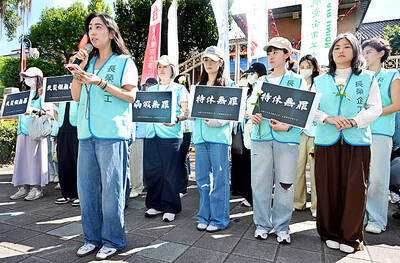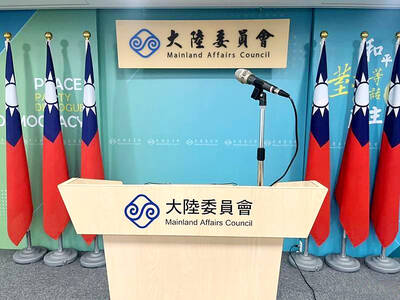Almost 70 percent of students in rural areas lack a device for online education, the Child Welfare League Foundation said, warning of a rise in educational inequality in Taiwan due to the COVID-19 pandemic.
Inadequate access to technology is among several educational obstacles young people in rural areas face, the foundation said, citing a survey it has conducted.
Foundation chief executive officer Pai Li-fang (白麗芳) said that pandemic-induced remote learning has highlighted educational inequality between urban and rural areas in Taiwan.
A local COVID-19 outbreak in May last year forced many schools to switch to online teaching, the foundation said.
However, about 66.7 percent of students in rural areas said they do not own a PC, tablet computer or any other device to access the Internet, while about 60 percent said they had to borrow a device from their school or share one with others.
About 20 percent of respondents used smartphones for online learning, as they did not own a PC or tablet, the survey found.
People in rural areas said they encountered more technological hurdles, with only 52.2 percent of families in rural areas having an Internet connection at home, the poll showed.
More than 60 percent of respondents said they did not have a separate and quiet space to attend online classes, while about 46.6 percent said the spaces they used for remote learning lacked sufficient lighting.
More than 20 percent of respondents said they were left alone at home without their parents or were accompanied only by their siblings after school was suspended due to the pandemic.
Only about 42 percent of respondents said their parents accompany them when doing homework and only 47.6 percent said their parents helped them when they had problems with online learning.
More than 20 percent said they worried that they would fall behind in school due to the way COVID-19 changed learning.
Pei said the survey shows how remote learning has exacerbated the rural-urban divide in education in Taiwan.
Young people in rural areas also face challenges related to their economic and living conditions, Pei said.
The survey found that 47.5 percent of respondents could not afford three meals a day, as the pandemic had affected their family’s finances.
According to the survey, 34.1 percent did not have enough resources to meet their daily needs.
The poll showed that 40.4 percent lacked disease prevention materials, with nearly 70 percent saying they feared contracting COVID-19.
The poll collected 1,035 valid questionnaires from students aged 11 and 12 from about 400 schools in rural areas nationwide.

A drunk woman was sexually assaulted inside a crowded concourse of Taipei Railway Station on Thursday last week before a foreign tourist notified police, leading to calls for better education on bystander intervention and review of security infrastructure. The man, surnamed Chiu (邱), was taken into custody on charges of sexual assault, taking advantage of the woman’s condition and public indecency. Police discovered that Chiu was a fugitive with prior convictions for vehicle theft. He has been taken into custody and is to complete his unserved six-month sentence, police said. On Thursday last week, Chiu was seen wearing a white

The Taoyuan Flight Attendants’ Union yesterday vowed to protest at the EVA Air Marathon on Sunday next week should EVA Airway Corp’s management continue to ignore the union’s petition to change rules on employees’ leave of absence system, after a flight attendant reportedly died after working on a long-haul flight while ill. The case has generated public discussion over whether taking personal or sick leave should affect a worker’s performance review. Several union members yesterday protested at the Legislative Yuan, holding white flowers and placards, while shouting: “Life is priceless; requesting leave is not a crime.” “The union is scheduled to meet with

‘UNITED FRONT’ RHETORIC: China’s TAO also plans to hold weekly, instead of biweekly, news conferences because it wants to control the cross-strait discourse, an expert said China’s plan to expand its single-entry visa-on-arrival service to Taiwanese would be of limited interest to Taiwanese and is a feeble attempt by Chinese administrators to demonstrate that they are doing something, the Mainland Affairs Council said yesterday. China’s Taiwan Affairs Office (TAO) spokesman Chen Binhua (陳斌華) said the program aims to facilitate travel to China for Taiwanese compatriots, regardless of whether they are arriving via direct flights or are entering mainland China through Hong Kong, Macau or other countries, and they would be able to apply for a single-entry visa-on-arrival at all eligible entry points in China. The policy aims

The government yesterday donated US$200,000 to the Philippines to support post-earthquake relief and recovery efforts, following a powerful magnitude 6.9 quake that struck Cebu Province late last month, killing at least 72 people and injuring 559 others. The donation was presented earlier yesterday by Representative to the Philippines Wallace Chow (周民淦) to Cherbett Maralit, deputy resident representative of the Manila Economic and Cultural Office, at Taiwan’s representative office in Manila. In his remarks, Chow expressed concern for those affected by the magnitude 6.9 earthquake that struck the central Philippines on the night of Sept. 30. "We sincerely hope for the earliest possible